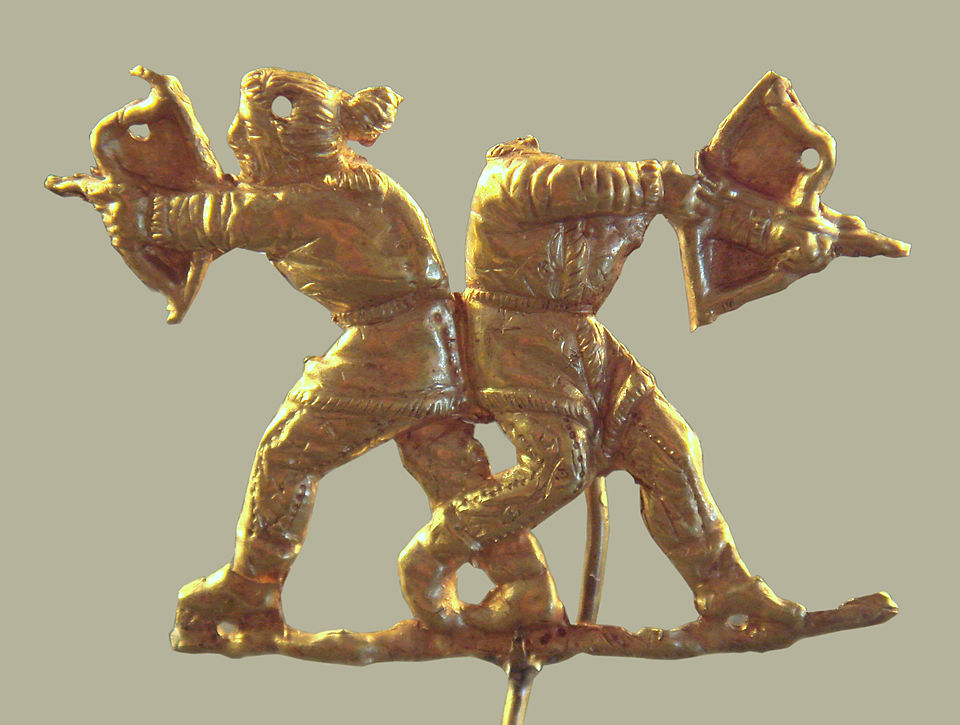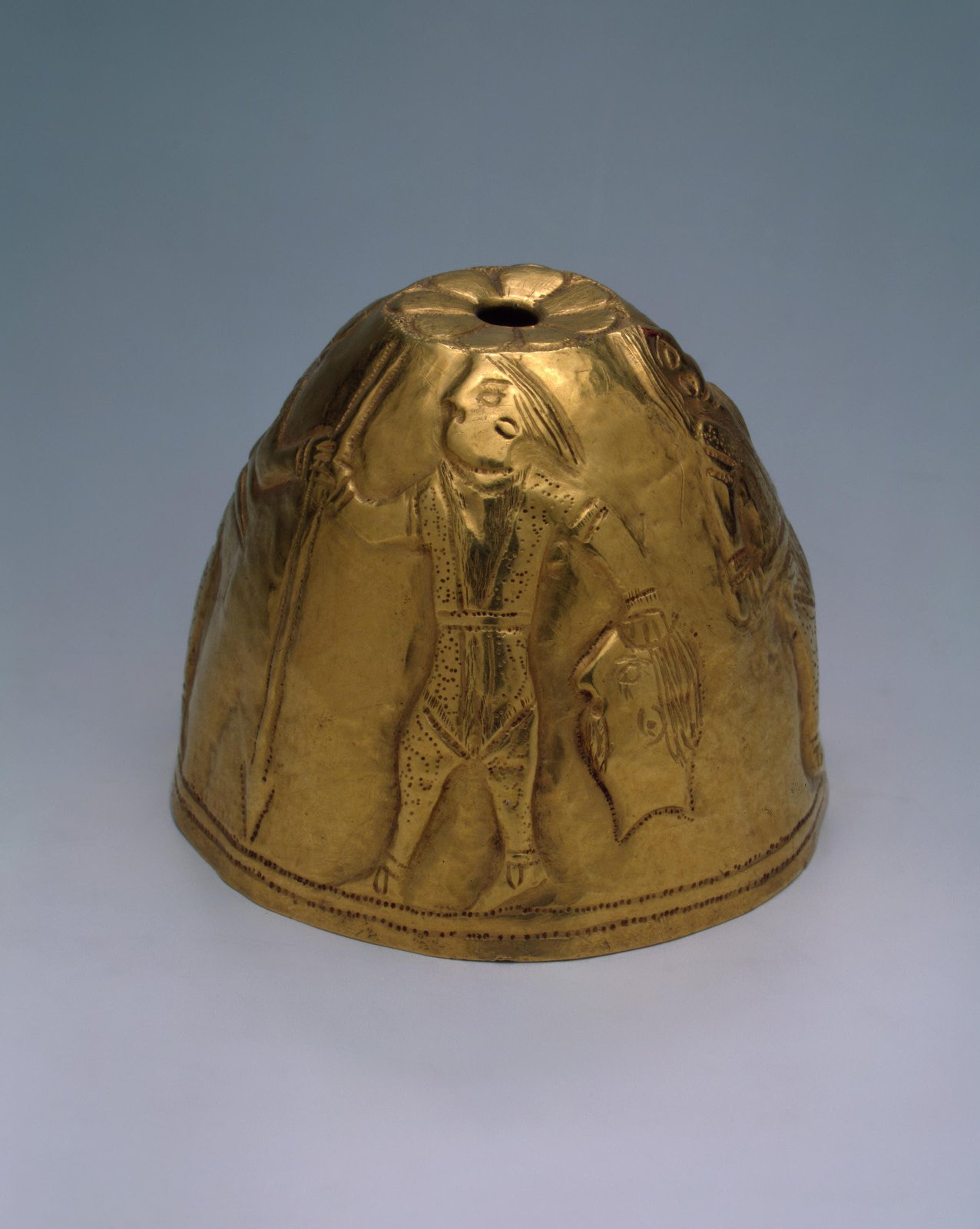Assorted Social Practices and Customs
Funerary rituals/practices
Herodotus mentions some funerary practices for several Scythian tribes in the Pontic Steppe area as well as relevant perspectives on adopting foreign customs.
40-day post-mortem tour
According to Herodotus (Histories 4.71), the Pontic Scythians embalm their dead (or, at least, their kings and those in the ruling class) and then tour the preserved bodies for an extended period before burying them in kurgans:
Whenever their king has died, the Scythians dig a great four-cornered pit in the ground there; when this is ready, they take up the dead man—his body enclosed in wax, his belly cut open and cleaned and filled with cut marsh-plants and frankincense, and parsley and anise seed, and sewn up again—and transport him on a wagon to another tribe. Then those who receive the dead man on his arrival do the same as do the Royal Scythians: that is, they cut off a part of their ears, shave their heads, make cuts around their arms, tear their foreheads and noses, and pierce their left hands with arrows. From there, the escorts transport the king’s body on the wagon to another of the tribes that they rule, and those to whom they have already come follow them; and having carried the dead man to all in turn, they are at the place of burial, in the country of the Gerrhi, the farthest distant tribe of all under their rule. Then, having laid the body on a couch in the tomb, they plant spears on each side of the body and lay wooden planks across them, which they then roof over with braided osiers; in the open space which is left in the tomb they bury one of the king’s concubines, his cupbearer, his cook, his groom, his squire, and his messenger, after strangling them, besides horses, and first-fruits of everything else, and golden cups; for the Scythians do not use silver or bronze. Having done this, they all build a great barrow of earth, vying eagerly with one another to make this as great as possible.
Herodotus also notes (4.73) that
All other Scythians, when they die, are laid in wagons and carried about among their friends by their nearest of kin; each receives them and entertains the retinue hospitably, setting before the dead man about as much of the fare as he serves to the rest. All but the kings are carried about like this for forty days and then buried. After the burial the Scythians cleanse themselves as follows: they anoint and wash their heads and, for their bodies, set up three poles leaning together to a point and cover these over with wool mats; then, in the space so enclosed to the best of their ability, they make a pit in the center beneath the poles and the mats and throw red-hot stones into it.
Ritualized cannibalism
Herodotus (4.26) describes a cannibalistic practice by the Issedones, who live far to the east or north-east of the Pontic Steppes Scythians:
It is said to be the custom of the Issedones that, whenever a man’s father dies, all the nearest of kin bring beasts of the flock and, having killed these and cut up the flesh, they also cut up the dead father of their host, and set out all the flesh mixed together for a feast. As for his head, they strip it bare and clean and gild it, and keep it for a sacred relic, to which they offer solemn sacrifice yearly. Every son does this for his father, just like the Greeks in their festivals in honor of the dead. In other respects, these are said to be a law-abiding people, too, and the women to have equal power with the men.
Sacrifice of servants
Per Herodotus (4.72), the Pontic Scythians sacrificed the willing servants of a dead ruler, along with the ruler’s horses, one year after the ruler’s death:
They take the most trusted of the rest of the king’s servants (and these are native-born Scythians, for only those whom he tells to do so serve the king, and none of the Scythians have servants bought by money) and strangle fifty of these and fifty of their best horses and empty and clean the bellies of them all, fill them with chaff, and sew them up again. Then they fasten half of a wheel to two posts, the hollow upward, and the other half to another pair of posts, until many posts thus prepared are planted in the ground, and, after driving thick stakes lengthways through the horses' bodies to their necks, they place the horses up on the wheels so that the wheel in front supports the horse’s forequarters and the wheel behind takes the weight of the belly by the hindquarters, and the forelegs and hindlegs hang free; and putting bridles and bits in the horses' mouths, they stretch the bridles to the front and fasten them with pegs. Then they take each one of the fifty strangled young men and mount him on the horse; their way of doing it is to drive an upright stake through each body passing up alongside the spine to the neck leaving enough of the stake projecting below to be fixed in a hole made in the other stake, which passes through the horse. So having set horsemen of this fashion around the tomb, they ride away.
Games
Hare-chasing
Herodotus (Histories 4.134) provides one noteworthy example of a game–chasing a rabbit on horseback–that turned the tide for Darius' attempted invasion of Scythia, leading the Persian ruler to withdraw and return home:
But when the Scythian ranks were set in order, a rabbit ran out between the armies; and every Scythian that saw it gave chase. So there was confusion and shouting among the Scythians; Darius asked about the clamor among the enemy; and when he heard that they were chasing a rabbit, he said to those with whom he was accustomed to speak, “These men hold us in deep contempt; and I think now that Gobryas' opinion of the Scythian gifts was true. Since, then, my own judgment agrees with his, we need to consider carefully how we shall return safely.”
Unknown carpet-board game
It has been speculated that the design on the famous Pazyryk carpet is meant to serve as the board for a game of some kind, although its nature and rules are unknown (if this even is an accurate interpretation of the carpet’s layout).
Oaths
Blood oaths \ Oaths of brotherhood and alliance
The swearing of oaths was, at least according to Herodotus, a gravely serious practice.
Herodotus describes one such blood-oath practice in 4.70:
As for giving sworn pledges to those who are to receive them, this is the Scythian way: they take blood from the parties to the agreement by making a little cut in the body with an awl or a knife, and pour it mixed with wine into a big earthenware bowl, into which they then dip a scimitar and arrows and an axe and a javelin; and when this is done those swearing the agreement, and the most honorable of their followers, drink the blood after solemn curses.
A set of plaques from a barrow in Kerch has been suggested to show two Scythians who have sworn a blood oath via their back-to-back stances defending one another and themselves.
Scalp collection/display
Herodotus describes a common practice of scalping one’s enemies and sewing the scalps into clothing (4.64):
He scalps the head by making a cut around it by the ears, then grasping the scalp and shaking the head off. Then he scrapes out the flesh with the rib of a steer, and kneads the skin with his hands, and having made it supple he keeps it for a hand towel, fastening it to the bridle of the horse which he himself rides, and taking pride in it; for he who has most scalps for hand towels is judged the best man. Many Scythians even make garments to wear out of these scalps, sewing them together like coats of skin. Many too take off the skin, nails and all, from their dead enemies' right hands, and make coverings for their quivers;the human skin was, as it turned out, thick and shining, the brightest and whitest skin of all, one might say. Many flay the skin from the whole body, too, and carry it about on horseback stretched on a wooden frame.
For centuries, this description was conjectured to be exaggeration so as to underscore the uncivilized and threatening nature of the barbaric Scythians compared to Greeks. However, in late 2023, Brandt et al. discovered that some leather from Scythian burials did in fact contain human DNA (emphasis added to the following blockquote):
Leather was one of the most important materials of nomadic Scythians, used for clothing, shoes, and quivers, amongst other objects. However, our knowledge regarding the specific animal species used in Scythian leather production remains limited. In this first systematic study, we used palaeoproteomics methods to analyse the species in 45 samples of leather and two fur objects recovered from 18 burials excavated at 14 different Scythian sites in southern Ukraine. Our results demonstrate that Scythians primarily used domesticated species such as sheep, goat, cattle, and horse for the production of leather, while the furs were made of wild animals such as fox, squirrel and feline species. The surprise discovery is the presence of two human skin samples, which for the first time provide direct evidence of the ancient Greek historian Herodotus’ claim that Scythians used the skin of their dead enemies to manufacture leather trophy items, such as quiver covers. We argue that leather manufacture is not incompatible with a nomadic lifestyle and that Scythians possessed sophisticated leather production technologies that ensured stable supply of this essential material.
Skull collection/use
According to Herodotus, the Pontic Scythians also collected the skulls of their enemies, whether to present to their kings in order to receive a share of the booty (4.64) or to turn into a drinking vessel (4.65).
There are a few depictions of Scythians holding the decapitated head of an enemy, such as on a helmet from Kurdzhipsky barrow, suggesting one or both of the above purposes could potentially have been truthfully reported.
Statements on responding to ancestral/burial defilement
According to Herodotus (4.125-127), Darius' attempt to conquer the Pontic Scythian steppes was disrupted in part by the Scythians' tendency to attack and then flee on horseback rather than engage in a pitched battle. Darius sent a messenger to tell the Scythians to submit, given their apparent weak status in comparison to the Persians. The Scythian king Idanthyrsus, in response, said (4.127.1-4):
It is like this with me, Persian: I never ran from any man before out of fear, and I am not running from you now; I am not doing any differently now than I am used to doing in time of peace, too. As to why I do not fight with you at once, I will tell you why. We Scythians have no towns or cultivated land, out of fear for which, that the one might be taken or the other wasted, we would engage you sooner in battle. But if all you want is to come to that quickly, we have the graves of our fathers. Come on, find these and try to destroy them: you shall know then whether we will fight you for the graves or whether we will not fight. Until then, unless we have reason, we will not engage with you. As to fighting, enough; as to masters, I acknowledge Zeus my forefather and Hestia queen of the Scythians only. As for you, instead of gifts of earth and water I shall send such as ought to come to you; and for your boast that you are my master, I say “Weep!”

